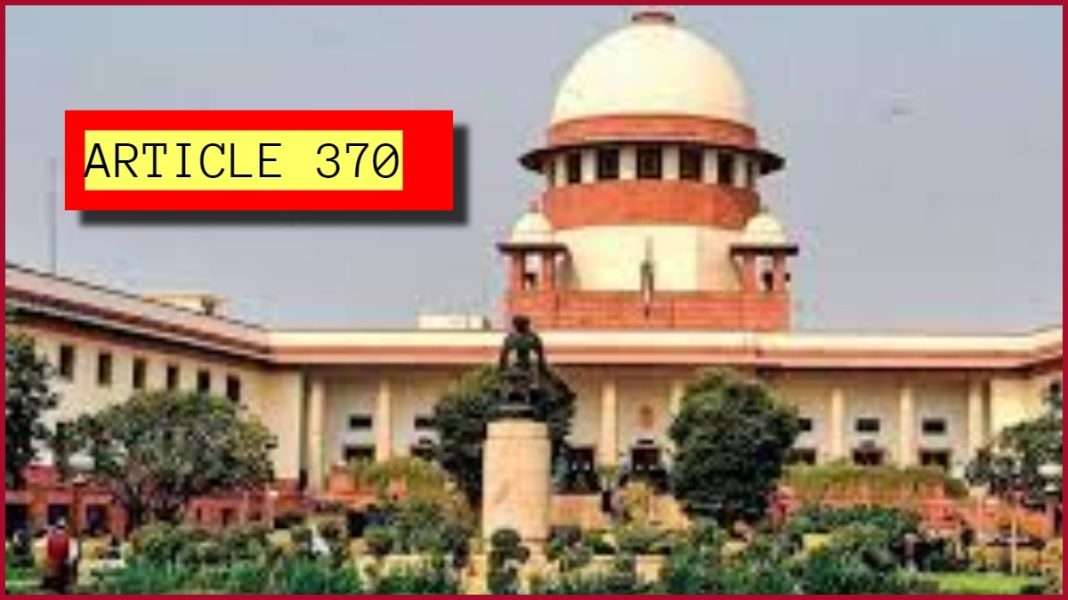By Neha Singh
New Delhi, Aug 10: Four years after the special status of Jammu and Kashmir under Article 370 of the Constitution was abrogated by the Central Government, the most awaited anticipated hearing of the petitions challenging the decision started in the Supreme Court on August 2, 2023. This petition has also challenged the Jammu & Kashmir Re-organisation Act 2019 which bifurcated J&K into Union Territories of J&K and Ladakh.
The hearing on the same has been lying dormant in the Supreme Court for more than three years. It was last listed in March 2020- and the hearing is currently underway for the final proceedings.
The batch of petitions are being heard by the five senior most judges of the top Court- Chief Justice D.Y. Chandrachud, Sanjiv Khanna, S.K. Kaul, Surya Kant and B.R. Gavai. The batch of petitions challenging the Union’s 2019 Orders which effectively abrogated this special status given to the State will be heard.
It must be noted that the special status of Jammu and Kashmir was removed on August 6, 2019.
What is Article 370?
The British colonization in India came to an end with Indian Independence Act of 1947 to the partition of British India into two Independent country-India and Pakistan. While, the Instrument of Accession (IoA) was introduced. The IoA allowed the rulers of the princely states, which were under British paramountcy, to choose between joining India or Pakistan.
Maharaja Hari Singh, the last ruler of Jammu and Kashmir, signed the Instrument of Accession (IoA) acceding to the Dominion of India on October 26th, 1947. Maharaja Hari Singh agreed to allow the Parliament to govern three subjects and limited the Center’s powers to Defence Foreign Affairs, and Communications.
At a time when India was drafting its Constitution, it was proposed that only those provisions of the Indian Constitution corresponding to the original IoA should apply to the State of J&K.
It was on October 27, 1949 when Article 370 was incorporated into the Indian Constitution under Part XXI, titled “Temporary, Transitional, and Special Provisions”. Article 370 granted special status to Jammu & Kashmir and permitted the state to draft its own Constitution.
Only the President of India could make any provisions of the Constitution to apply to this State with ‘modifications’ or ‘exceptions’, but it required only in ‘consultation with the Government of the State’. Also, Article 370 itself could not be amended or repealed—until and unless the Constituent Assembly of Jammu & Kashmir consented to it.
However it was on January 25, 1957 that the State’s constituent assembly dissolved itself without recommending either the abrogation or amendment of Article 370.

Abrogation of Article 370
It was on August 6, 2019 when the Lok Sabha passed the statutory resolution and the Reorganisation Act which was approved in the Rajya Sabha on August 5.
The Bharatiya Janata Party (BJP) for the 2009, 2014 and 2019 General Elections affirmed its intention to abrogate Article 370 in their manifesto. On August 5 and August 6, 2019, The BJP government dissolved Article 370 with two Presidential Orders—CO 272 and CO 273.
The first Order which was issued on August 5, 2019, amended Article 367 which dealt with the interpretation of the Constitution. The Order stated that the phrase ‘Constituent Assembly’ under Article 370 will be read as ‘Legislative Assembly’ of the State.
At the time when the Article 370 was abrogated, Jammu and Kashmir was under President’s Rule, by which its Legislative Assembly and Governor were replaced with the Union Parliament and the President.
Soon after this Order, a Statutory Resolution was passed by both houses of Parliament recommending that Article 370 be dissolved.
On August 6, 2023, then President Ram Nath Kovind issued the second Order which held that Article 370 ceased to operate and that Jammu and Kashmir was a part of the Union of India.
On August 9, 2019, after the abrogation of Article 370 the Indian Parliament passed the Jammu and Kashmir Reorganisation Act, 2019. This resulted into two Union Territories—Jammu and Kashmir and Ladakh. Earlier, it had a legislative Assembly and the latter did not.
Impact of Abrogation of Article 370
The abrogation of Article 370 removed the special status that was granted to Jammu and Kashmir by the Constitution.
This means that the Indian Parliament can make laws for J&K and Ladakh and is no longer restricted to three subjects.
The Constitution and other territorial laws of India will also be applied to Jammu and Kashmir and Ladakh as they would to any other State or Union Territory in the Country. Also, this region will have a separate flag.
Talking about the benefit after the abrogation of Article 370 is that the ‘permanent citizens’ of Jammu and Kashmir were granted the right to own and acquire property within the region stands dissolved.
Also Read: NDA ally MNF to vote in support of INDIA’s no-confidence motion
Also Watch
Find latest news from every corner of Northeast India at hubnetwork.in, your online source for breaking news, video coverage.
Also, Follow us on-
Twitter-twitter.com/nemediahub
Youtube channel- www.youtube.com/@NortheastMediaHub2020
Instagram- www.instagram.com/nemediahub





